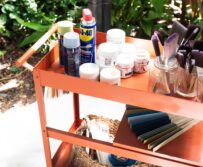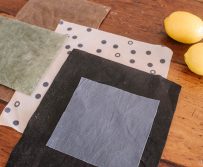Because you love your succulents, don’t you? And you don’t want to kill them!
Succulents are some of the best plants for the house, they’re incredibly pretty and *somewhat* low maintenance. But if you’re finding that your succulents aren’t lasting as long as you thought they might, or you just stocked up on them and have no ideahow to look after them, maybe you need a little help in the succulent department. And we’re here to help! A long time ago when I was first getting into indoor plants, I quizzed my local nursery owner for some succulent tips and jotted down on this blog everything he told me. Little did I know that post would become one of the most popular on this site (and cause Google to classify us under Home & Gardening… true story!). With over a million people having read it and my knowledge on the subject growing in the last few years too, we felt it was time to do an update. This time around? We’re going to do a series of illustrated posts that you can refer to so you know the basics. First up, a simple care reference guide.
An Illustrated Guide To Caring For Your Succulent
Light
Succulents need at least 6 hours of sunlight per day. But avoid placing your succulents in areas of harsh, direct sunlight, or they will get sunburnt. Yes this is a real thing!
Placement
On the subject of light, place your succulents near windows so that they get plenty of sunlight. But avoid putting them near windows that face the midday sun as this is when they will be exposed to the highest temperatures (and will need that succulent spf). If you only have a few sunny spots, make sure to rotate your plants now and again out of the darker areas so they get a top up of sunlight
Temperature
Succulents can generally tolerate temperatures between 21-29C/70-85F during the warmer months, and a minimum of 10-13C/50-55F during the colder months.
Watering
Succulents need plenty of water, but it’s crucial they don’t drown or sit with wet roots for too long. The key is to keep the succulent’s roots hydrated while letting them also drain properly. Water your succulents until the soil is wet, soaking in a sink is a good idea if you have time, and only water them again when they completely dry out. Succulents go through a dormant period during the winter months, so you won’t have to water them as frequently during those months.
Pots
Avoid glass containers and any containers without drainage holes for your succulents. Drainage holes in pots help with airflow and drying out the soil. Without them, your plant will easily drown in too much water, and may also attract bugs. If you do want to use a decorative pot without a hole, one option is to leave them in their plastic pots with the base underneath and then place that in the decorative pot, so they can drain into that.
Soil
Use a good draining soil for planting your succulents, like cactus soil, which mainly help with letting water drain out of the pot. You could also add sand or gravel to the soil mix to facilitate drainage. Any mold that develops on top of the soil or on the plant can often be traced back to soil that is too wet and draining poorly.
Fertilizer
Succulents don’t need a lot of fertilizer, but adding some once a month will help to add back the nutrients in the soil that gets lost through the watering and draining process. There are fertilizers made just for succulents, just be sure to check the label to see exactly how much you’ll need to add to your plant.
Re-potting
A general rule is to repot your succulents once every year, but symptoms such as the water sitting on top of the soil and not soaking through, the roots of the plant becoming too tightly packed and even sticking out of the drainage holes, or just the succulent itself growing too big for its container, means its time to repot.
Keep an eye out
The tips above are general, and I find they work for all the succulents I own. But because yours might come from different places in the world, you might find they need slightly different treatment, so just keep an eye on them when you first get them. Stay tuned for a post all about diagnosing any issues with your succulent!


























As always, you are so helpful! I have a bunch of succulents at home and never really give it much thought as to how to care for them. Now I know, so thank you!
https://www.makeandmess.com/
These are some really good tips! Thanks. And I am loving all of your succulents 🙂
http://www.thoughtsinstyle.com/
Oh my gosh this is so lovely and actually really useful! It would be awesome to give a succulent as a gift to someone & then point them to/print out your wonderful post to go with it. Love it!
Holly from The Art of Being Holly xo
This is an amazing and helpful post, thanks for sharing! I LOVE succulents. I buy them myself and they make great gifts.
Hannah | Wild At Heart
Also keep an eye out for mealy bug and aphids attacking indoor succulents. You can control both with rubbing alcohol and a q-tip (don”t use spray bottles). When you notice either DETAILED inspection/treatment of ALL PLANTS daily/weekly/bi-weekly/monthly. I have had succulents for a year, still treating bi-weekly. Dispose of weak damaged plants. Expect control not elimination, extremely determined pests. Otherwise, brilliant post
Succulents are so diverse. Half grow in winter! Never stop watering them especially if you kept them in warm temperatures constantly. You can trick succulents into keep growing. No they do not need fertilizer, but it will make some leggy, or even have them change colors. But in the summer, the least amount you water them, the more stress they become and the real colors come out. Jade is remarkable when stressed. Oh man I love it
Great tips! I feel like I take care of my plants pretty good but my cat likes to eat them unfortunately :'( http://www.poppydeyes.com/
I still remember my childhood cactus my mum managed to kill when I went away for 3 months because she thought cacti do not need any water anyway…
I may need to brag a little but this is the only plant I can keep alive haha =o)
https://dreamofadventures.com/
This post was much needed! I’m trying to get into gardening now that I have my own home and I’ve found that rather than having a green thumb… I have a brown one- poor plants lol . I think succulents will be the best start for me.